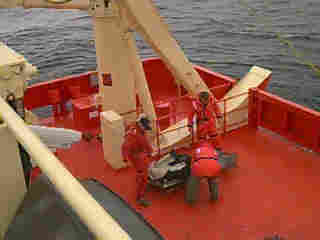
|
|
30 January, 1998
Gould-en Greetings:
The last few days we've had quite a few technical problems with equipment
that was being deployed (sent into the water to collect data). The
Antarctic Support Associates (ASA) people we have on board to help with
such problems have been working furiously to correct the difficulties. With
the cooperative efforts of the scientists and the ASA, it would appear that
most of the problems are clearing up. The scientists are breathing a sigh
of relief as the data they have come so far to get is now obtainable. The
other side of this is that we are now playing "catch up" with getting the
testing done. That means long hours of work and little sleep for awhile.
A small price to pay to get the information so dearly sought.
One way scientists gain the money and permission to do research in this
remote and often harsh environment is to write grant proposals to the
National Science Foundation (NSF). But Antarctica is such a unique area
for many reasons. Its very remoteness and harshness have kept people from
inhabiting the land as we have done on all the other continents. What are
some of the ways that the absence of people helps in studying an area?
Other organisms have managed to make Antarctica their home. To do so, they
have had to adapt to the special seasons, temperature, and nutrient (food)
availability that this place offers. Scientists come here from all over
the world to study these unique conditions and organism adaptations.
As this is such a special place, many people who are not scientists and
cannot get grants want to come here. Tourists must pay large amounts of
money to visit a small area of Antarctica. They usually come to the
peninsula area where we are working. Other areas are too far away and
dangerous to visit, as well as protected for scientific research only.
Others choose to leave friends and family to work here. At this time, the
agency that provides support for the United States research efforts is the
ASA, as mentioned before. One does not have to be a scientists to work
here. For example, Luke Emery specializes in computer technology, but does
much, much more such as helping folks like me send pictures to you from
Antarctica! Brian Williams is in constant demand to fix all manner of
electrical problems, including those on top of the tall mast on deck! (I'm
glad I do not have his job.) Rhonda Kelly is the Marine Projects
Coordinator and Alice Doyle is the Marine Projects Technician. Cooks,
technicians, and even those who crew the research vessels all make it
possible for scientists to concentrate more on their research than on how
the next meal will be prepared like the explorers had to in the past.
Others, such as Kim Grimm of San Diego, California, serve as volunteers to
help those researchers who do have grants accomplish a great amount of work
in a small amount of time. In this case, Kim works for Primary Investigator
(PI) Langdon Quetin, who is primarily studying zooplankton in Antarctic
waters on this cruise. Always with a smile and a kind word for others, Kim
helps with equipment use, deploying nets and acoustic devices. When the
organisms have been brought on board, Kim helps to separate them into their
separate groups, such as krill, amphipods, jellyfish, chaetognaths,
copepods and fish larvae. Those organisms may not be familiar to you
because they are very small and they are not well known unless that is the
parcticular area you study. However, these little organisms are very
important to the other animals here because they are food to a great many
animals, especially the krill. What animals do you think would eat krill,
small ones or big ones? The answer is BOTH! Penguins eat krill as a main
diet staple as do the baleen (filter-feeding) whales. Because they are so
important to the animals here, they are important to study. It is special
volunteers like Kim who make it possible for researchers to process the
enormous amount of information they must collect while here to work on the
rest of the year. Kim, in return, gets to experience this beautiful and
special place.
Today I worked on analyzing dissolved oxygen in the different depths of the
water. Of what importance is dissolved oxygen? Why do you think it
changes as the depth changes? To get the samples to analyze, a device
called a CTD (Conductivity-Temperature-Depth) was deployed. Along with the
CTD, special devices that close by electrical signal to capture water
samples at different depths, called GoFlow Bottles, are mounted around the
CTD in a cylindric frame.
I've enjoyed answering many of your questions that range from, "How cold is
it?" to "Does the 24 hour daylight have an effect on the scientists'
thinking processes?" It is not nearly as cold as some parts of the USA
mainland in this peninsula area. It has been a balmy 41 degrees for two
days in a row! As far as the scientists' mental processes are concerned,
as long as adequate sleep is obtained, I do not see any parcticular effect.
But of course, I have not done a proper study.
Warm regards,
Mrs. D

Contact the TEA in the field at
.
If you cannot connect through your browser, copy the
TEA's e-mail address in the "To:" line of
your favorite e-mail package.
|
